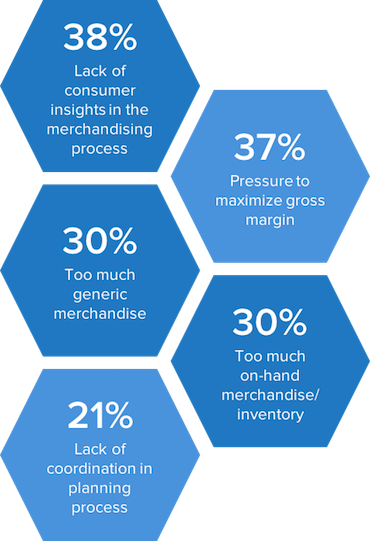Making the Case for a Customer-Centric Transformation in Merchandise Planning: Putting customers’ desires at the forefront of merchandise planning decisions
The trend towards customer-centric thinking within organizations has been underway for nearly a decade, but the emphasis has mainly been in areas like marketing and customer service. As the retail industry continues to grow more hyper-competitive, and the balance of power continues to shift from the retailer to the customer, companies need to focus on customer-centricity in their merchandise planning, just as much as they have in other areas, if they want to survive and, more importantly, thrive. Putting customers first in all aspects of a retail operation – from assortment planning to marketing and merchandising - has become a critical shift that organizations need to make.
Here are the key industry trends and what they mean for retail organizations going forward. These trends all point to the importance of customer-centricity in merchandise planning and the immense importance of having a customer-centric focus at the heart of every process within an organization in order to succeed in today’s retail landscape.
Key Trend #1: Planned Assortment Opportunity Gap
A shift is occurring in customer segments across varied categories and retailers that miss this shift are missing a large opportunity. This “opportunity gap” especially impacts soft lines where lead times can be long, but the cycle time for products can be very short.
This coupled with the fact that consumer spending and confidence is on the rise again has led to the emergence of more customer segments than ever before. Millennials, for example, have immense buying power and expect their desired assortments to be available, which can be completely different product assortments than what other important customer segments desire. These emerging customer segments have and will continue to influence a lot of the assortment mix. A customer-centric merchandise planning organization needs to take into account all of the groups that shop its brand and devise strategies that reach each one.
Key Trend #2: Amazon’s Impact as a Disruptor
Everyone knows Amazon and is impressed by their business strategies and ability to dominate the categories they’re in. However, Amazon is constantly being overlooked by companies as a viable competitor because they don’t have brick and mortar stores. This is a huge mistake because Amazon is a shining example of a successful customer-centric company.
Amazon is a disruptor in multiple areas that affect retail and brand companies and, as a result, is a threat to their business models. Examples of this are Amazon’s rapid expansion of their network for sourcing and procurement in order to expand their product offerings to meet customer needs, their ability to enter and dominate new categories (like apparel) and their ability to build an incredibly strong loyalty program (Amazon Prime). The manner in which they accomplish and dominate each of these areas is astounding and at the fore-front of what the future of the retail industry is going to look like. Their customer-centric strategies enable them to give their customers what they want before they even know they want it and this is something that all retailers – not just eCommerce players – should be paying close attention to.
Key Trend #3: Predictive Analytics
Capturing and properly utilizing the information obtained from predictive analytics will play a significant role in the ability of retailers to embrace customer centricity. This includes the ability to predict customers’ desires and buying patterns, as well as where they shop and why. It is not just causal relationships that are important – all the inventory in the store and all of the assortments have a core relationship with a specific customer segment, type of buyer behavior and type of purchase journey.
The information gained from predictive analytics must influence how retailers approach their strategies for every aspect of their business, such as on-hand inventories and online versus in-store regional assortments. Successful retailers need to employ predictive analytics to map out the customer’s purchase journey and to fully understand the components that drive the customer to the store or website and influence the way they ultimately buy (or don’t buy) a product.
Key Trend #4: Digital
Digital is one of the fastest growing trends influencing customer behavior in retail right now and is ever-evolving. A great example of digital’s relevance as a major trend is last year’s Black Friday when mobile transactions skyrocketed to levels never seen before. The growth of mobile channel transactions in comparison to growth seen in-store and eCommerce is telling – mobile will continue to be a huge avenue in which consumers buy products. Strategies surrounding mobile clearly need to be focused on understanding how customers want to be served.
Key Trend #5: Globalization vs Localization
More and more companies are finding out that their sales are local, but their strategies are becoming global. As retailers are constantly searching for the next way to grow their businesses, it is imperative that they look outwards at growth and expansion. Whether that’s growing through opening stores in new countries, or through digital and other omni-channel avenues, or through international partnerships, the core question remains the same – how can I successfully reach customers in these new areas? Selling locally but acting globally will require a deep understanding of customers in each local market.
Translating Data into an Executable Customer-Centric Strategy
 According to a recent EKN survey, 38% of retailers say they find it difficult to plan assortments due to a lack of consumer insights in the merchandising process. The takeaway is that companies are collecting data, but they are either collecting the wrong data, or do not know how to translate the data they have into executable business strategies in their assortments.
According to a recent EKN survey, 38% of retailers say they find it difficult to plan assortments due to a lack of consumer insights in the merchandising process. The takeaway is that companies are collecting data, but they are either collecting the wrong data, or do not know how to translate the data they have into executable business strategies in their assortments.
Analyzing historical sales by segment to gain insights into the shopping behaviors of those segments is good, but not good enough. Companies must take a 360-degree view of the customer. This means taking into consideration unstructured data.
Knowing the things that influenced consumers to make the purchases they did in-store versus online or on their phones is crucial information that planners and category managers need to understand in order to devise future strategies. This information can translate into the creation of customer-centric strategies in top-down planning, promotions, sales management and overall assortment mix. A 360-degree view of the customer will help companies prioritize where they should put their resources.
Considering the trends referenced above, it is clear that shifting to a customer-centric merchandising approach is not only the right path for retailers going forward, but likely the only path to success. Making that shift, however, will involve a major changes across multiple dimensions of the organization. In Part 2 of this article, we will discuss those dimensions along with the key considerations for driving change.
See article on JustEnough's blog
Guest Experts
Sahir Anand, VP of Research and Principle Analyst, EKN
Peter Leith, VP of Product Strategy, JustEnough

